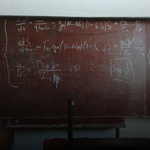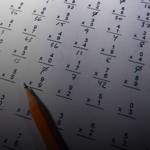Section 1
Preview this deck
limit as x approaches 0: 1-cosx/x
Front
Active users
0
All-time users
0
Favorites
0
Last updated
4 years ago
Date created
Mar 1, 2020
Cards (73)
Section 1
(50 cards)
limit as x approaches 0: 1-cosx/x
0
d/dx(sinx)
cosx
v(t) and a(t) has same signs
speed of particle increasing
Quotient rule of f(x)/g(x)
g(x)f'(x)-f(x)g'(x)/g(x)²
Chain rule of f(x)^n
nf(x)f'(x)
limit as x approaches 0: sinx/x
1
∫(e^kx)dx
ekx/k +C
Extreme Value Theorem
if f(x) is continuous on [a,b], then f(x) has an absolute max or min on the interval
d/dx(cosx)
-sinx
a(t)<0
v(t) decreasing
∫sec²x dx
tanx+C
Mean Value Theorem
if f(x) is continuous on [a,b] and differentiable on (a,b), there is at least one point (x=c) where f'(c)= F(b)-F(a)/b-a
∫sinx dx
-cosx+C
Limit Definition of Derivative
limit (as h approaches 0)= F(x+h)-F(x)/h
v(t)=0
p(t) is at rest or changing direction
d/dx(secx)
secxtanx
If f''(x)<0
f(x) is concave down & f'(x) is decreasing
If f'(x)=0
there is a max or min on f(x) [number line test]
d/dx(lnu)
u'/u
d/dx(tanx)
sec²x
v(t)<0
p(t) is moving left
∫k dx [k IS A CONSTANT]
kx+C
∫csc²x dx
-cotx+C
Rolle's Theorem
if f(x) is continuous on [a,b] and differentiable on (a,b), and if f(a)=f(b), then there is at least one point (x=c) on (a,b) [DON'T INCLUDE END POINTS] where f'(c)=0
If f''(x)>0
f(x) is concave up & f'(x) is increasing
∫cosx dx
sinx+C
v(t) and a(t) has different signs
speed of particle decreasing
p(t), x(t), s(t)
means position function
Product rule of f(x)g(x)
f'(x)g(x)+g'(x)f(x)
d/dx(cscx)
-cscxcotx
∫(x^n)dx
x^(n+1)∕(n+1) +C
p''(t) or v'(t)
a(t)= acceleration
∫cscxcotx
-cscx+C
a(t)=0
v(t) not changing
d/dx(cotx)
-csc²x
If f'(x)>0
f(x) is increasing
If f''(x)=0
f(x) has a point of inflection & f'(x) has a max or min
d/dx(a^u)
a^u(lna)(u')
∫secxtanx dx
secx+C
If f'(x)<0
f(x) is decreasing
a(t)>0
v(t) increasing
Basic Derivative
f(x^n)= nX^(n-1)
∫(1/x)dx
ln|x|+C
Intermediate Value Theorem
if f(x) is continuous on [a,b], then there will be a point x=c that lies in between [a,b]
Alternate Definition of Derivative
limit (as x approaches a number c)= f(x)-f(c)/x-c x≠c
1st fundamental theorem of calculus
(bounded by a to b) ∫f(x)dx= F(b)-F(a)
v(t)>0
p(t) is moving right
p'(t)
v(t)= velocity
d/dx(e^u)
e^u(u')
Continuity Rule
If the limit exists (aka left limit and right limit are equal), and the limit equals the function at that point.
Section 2
(23 cards)



